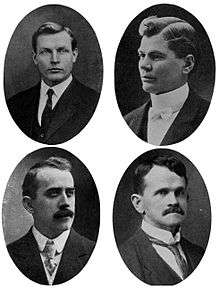1911 Brigham Young University modernism controversy

The 1911 modernism controversy at Brigham Young University was an episode involving four professors at Brigham Young University (BYU), who between 1908 and 1911 widely taught evolution and higher criticism of the Bible, arguing that modern scientific thought was compatible with Christian and Mormon theology. The professors were popular among students and the community but their teachings concerned administrators, and drew complaints from stake presidents, eventually resulting in the resignation of all four faculty members, an event that "leveled a serious blow to the academic reputation of Brigham Young University—one from which the Mormon school did not fully recover until successive presidential administrations."[1]
History
In 1907, BYU president George H. Brimhall began hiring a new group of faculty to increase the academic reputation of his school. Joseph Peterson was hired to teach psychology, and his brother Henry Peterson hired as the director of the College of Education. Joseph Peterson was the first Ph.D on the faculty of BYU. In 1908 and 1909 Brimhall hired Ralph Vary Chamberlin and his brother William Henry Chamberlin, to teach biology and philosophy, respectively. The Chamberlin and Peterson brothers, while devout Mormons, actively sought to increase the intellectual atmosphere of the university and community, facilitating discussion and debates on evolution and the Bible, and sought to convey that evolutionary ideas and Mormon theology were not mutually exclusive, but rather complementary. Horace H. Cummings, the superintendent of the church schools, felt especially that teaching religion from non-Mormon sources and teaching evolution was contrary to Latter-Day Saint teachings.[1] The four instructors' courses were popular among students and other faculty, but university and church officials accused the professors of promoting heretical views, and in 1911 offered the Petersons and Ralph Chamberlin a choice: alter their teachings or lose their jobs. Privately, Joseph B. Keeler told Ralph Chamberlin privately he could stay, but he refused, as the Petersons weren't given the same offer.[2]
This ignited a great deal of controversy in the school and surrounding community. The students of BYU overwhelmingly supported the professors, and a petition of support signed by at least 80% of the student body was submitted to BYU officials and reprinted in the Salt Lake Tribune, Salt Lake City's largest secular newspaper. Unwilling to change their teachings, the Petersons and Ralph Chamberlin left the university in 1911, while William remained for another 5 years, resigning in 1916.[1][3][4]
The loss of the faculty represented an intellectual loss to the university, and a stifling effect on students as well as faculty.[1][5] Milton Bennion, writing in March 1911, called the conflict the most significant event in Utah's recent educational history.[6] Ann Weaver Hart wrote that the 1911 BYU controversy made Utah comparatively less emotional and reactionary than other parts of the country during the 1925 Scopes Monkey Trial.[7]
See also
- Mormon views on evolution
- History of Brigham Young University
- Creation and evolution in public education in the United States
References
- 1 2 3 4 Bergera, Gary James (1993). "The 1911 Evolution Controversy at Brigham Young University". In Sessions, Gene A.; Oberg, Craig J. The Search for Harmony: Essays on Science and Mormonism. Salt Lake City: Signature Books. pp. 23–41. ISBN 1-56085-020-5. OCLC 25873671.
- ↑ Chamberlin, Ralph. Ralph V. Chamberlin oral history interview, ID: MSS OH 238. Provo, Utah: L. Tom Perry Special Collections, Brigham Young University.
- ↑ Arrington, Leonard J.; Bitton, Davis (1992). "Church and Kingdom: Creative Adjustment and Reinvigoration". The Mormon Experience: A History of the Latter-Day Saints (2nd ed.). Urbana: University of Illinois Press. pp. 258–261. ISBN 9780252062360.
- ↑ Sherlock, Richard (January–February 1979). "Campus in Crisis: BYU's earliest conflict between secular knowledge and religious belief" (PDF). Sunstone (13): 10–16.
- ↑ Alexander, Thomas G. (1996). "Definition of a Role for the Church Educational System". Mormonism in Transition: a History of the Latter Day Saints; 1890-1930. Urbana: University of Illinois Press. pp. 171–174. ISBN 9780252065781.
- ↑ Bennion, Milton (March 1911). "The "evolution" and "higher criticism" controversy at the Brigham Young University". The Utah Educational Review. 4 (7): 9–10.
- ↑ Hart, Ann Weaver (1983). "Religion and Education: The Scopes Controversy in Utah". Utah Historical Quarterly. 51 (2): 183–198.
Further reading
- Wilkinson, Ernest L., ed. (1975). "Twixt Sand and Shoals: 1909-1921". Brigham Young University: The First One Hundred Years. Provo, Utah: Brigham Young University Press. pp. 403–457.
- Gary James Bergera & Ronald Priddis (1985). "The Organic Evolution Controversy". Brigham Young University: A House of Faith. Salt Lake City: Signature Books. pp. 131–171. ISBN 0-941214-34-6.
- Joseph F. Smith (1911). "Theory and Divine Revelation". Improvement Era. General Board, Y.M.M.I.A. 14: 548–551.
![]() Texts on Wikisource:
Texts on Wikisource:
- Evolution and Theological Belief, R. V. Chamberlin
- Some Early Hebrew Legends, R. V. Chamberlin
- The Early Hebrew Conception of the Universe, R. V. Chamberlin
- The Theory of Evolution as an Aid to Faith in God and Belief in the Resurrection, W. H. Chamberlin
- "B. Y. U. Students Destroy Reply of the Presidency and Make Public the Protest They Formulated"- Salt Lake Tribune, March 16, 1911